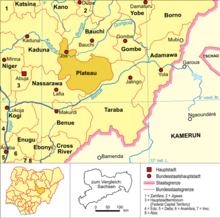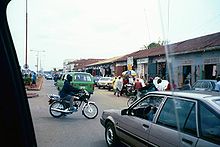Jos
| Jos | ||
|---|---|---|
|
|
||
| Coordinates | 9 ° 55 '0 " N , 8 ° 53' 0" E | |
| Basic data | ||
| Country | Nigeria | |
| plateau | ||
| ISO 3166-2 | NG-PL | |
| height | 1250 m | |
| surface | 50 km² | |
| Residents | 860,000 (2007) | |
| density | 17,200 Ew. / km² | |
Jos [ dʒɔːs ] is the capital of the Nigerian state of Plateau and is located in eastern central Nigeria. According to an estimate from 2007, it has around 860,000 inhabitants. This makes the city, which gives the Josplateau its name , the eleventh largest in Nigeria.
geography
The city is located on the northern edge of the Jos plateau in central Niger , on the banks of the Delimi at 1250 meters above sea level. It has an area of about 50 km² and is located about 300 km from the capital Abuja . Except in the north, Jos is surrounded on all sides by mountains. In the north the Dogon Dutse and the Shere reach a height of 1,300 and 1,400 m respectively, in the west lies the 1,300 m high Jenta mountain.
City structure
Of the 17 Local Government Areas (LGA) in the state of Plateau, three are in the urban area of Jos. They represent independent municipalities in the geographical urban area; there is no political urban area.
| LGA | Administrative headquarters | Area in km² | Population (1991 census) |
|---|---|---|---|
| Jos-Nord | Jos | 291.49 | 392.831 |
| Jos-East | Angware | 1019.55 | 55,884 |
| Jos-South | Bukuru | 509.84 | 202.124 |
climate
With average temperatures of 21 to 25 degrees Celsius, Jos has a much cooler climate than other cities in the country. From December to January the average minimum temperatures are below 15 ° C, in the warmest period from March to April the average maximum values reach up to 30 ° C. The annual precipitation is around 1,400 mm.
| Jos | ||||||||||||||||||||||||||||||||||||||||||||||||
|---|---|---|---|---|---|---|---|---|---|---|---|---|---|---|---|---|---|---|---|---|---|---|---|---|---|---|---|---|---|---|---|---|---|---|---|---|---|---|---|---|---|---|---|---|---|---|---|---|
| Climate diagram | ||||||||||||||||||||||||||||||||||||||||||||||||
| ||||||||||||||||||||||||||||||||||||||||||||||||
|
Monthly average temperatures and precipitation for Jos
Source: wetterkontor.de
|
|||||||||||||||||||||||||||||||||||||||||||||||||||||||||||||||||||||||||||||||||||||||||||||||||||||||||||||||||||||||||||||||||||||||||||||||||||||||||||||||||||||
history
Jos lies on the edge of the range of the prehistoric Nok culture . Terracotta finds on the Josplateau prove that the area around Jos as early as 500 BC. Was settled. The present city was founded at the beginning of the 20th century by the British colonial powers on the site of the village of Geash , which was inhabited by the Berom, Jawara and Anaguta ethnic groups. In 1905 the Royal Niger Company began the industrial mining of columbite and tin in the Jos area .
The origin of the name Jos is not known. Some believe that the first European settlers mispronounced the name of the original village, geash or gwosh . According to another theory, Jos is an acronym for Jesus our Savior ("Jesus our Savior").
With the commissioning of the railway line to Port Harcourt in 1914, the city experienced a rapid boom that attracted British, Indian and Lebanese settlers. From 1927 it was possible to transport the tin over several hundred kilometers to the Loko seaport on the Benue River . Tin exports reached a high of 17,463 tons in 1943 during World War II , but fell after a price drop in the 1930s. Most of the mines are now part of the informal economy and still produce around 1000 tons annually.
The population rose from 8,000 in 1920 to 11,000 in 1931. At the time of independence in 1960, Jos had around 80,000 inhabitants. In the penultimate 1991 census, Jos had 637,036 inhabitants. The largest ethnic groups today are the Yoruba , Hausa , Igbo , Berom, Anaguta, Jawara and Afisere.
In 1967 Jos became the capital of the newly founded state of Benue Plateau. This split in 1976 into the states of Benue and Plateau with the capitals Makurdi and Jos. In September 2001 riots between Christian and Muslim populations left up to 1,000 dead. The government appointed a commission to investigate the events, the reports of which have not yet been made public. In further unrest the central market was devastated.
In November 2008 riots broke out in Jos after local elections. Supporters of Christian and Islamic parties accused each other of electoral fraud and clashed. Hundreds of people lost their lives.
In January 2010 there were again serious riots between Christian and Muslim militias in the Archdiocese of Jos , in which more than 200 people died. The Nigerian Vice President Goodluck Jonathan then sent military units to the crisis region. In March 2010 riots broke out again between members of the Fulani (Muslims) pastoral people against the Berom (Christians) villagers in Dogo Nahawa village, in which over 500 people died.
32 people died in a series of bombs on Christian churches in villages near Jos on Christmas Eve 2010. The attacks are followed by unrest and fighting between armed Christians and Muslims. According to Human Rights Watch , 200 people died between December 2010 and March 2011. Two people were killed in a bomb explosion in the vicinity of a Christian church on March 20, 2011. On the afternoon of May 20, 2014, two serious bomb attacks were carried out in Jos in quick succession. One of the two explosive devices exploded at a bus station, the other near a busy market. In total, at least 118 people lost their lives and there were numerous injuries.
Attractions
Because of the charming location and the pleasant climate, Jos is one of the most popular vacation spots in Nigeria .
One of the sights is a museum complex founded and built by the British archaeologist Bernard Fagg in 1952, the National Museum Jos with an extensive ceramic collection from the various regions of Nigeria. Other museum buildings show exhibits of the Nok culture , pictures of the excavation of the oldest boat in Africa (Dufunaboot), as well as an extensive collection of premonetary monetary systems, including manillas . An “industrial park” with vintage cars is also part of the museum complex. For various reasons the whole complex is in very bad condition.
Monkeys, lions, hippos and pythons can be seen in the city's zoo.
Economy and Infrastructure
economy
Jos is the center of Nigeria for the mining of tin and columbite and their smelting . The chemical, printing, food, steel and textile industries are also important branches of industry. Key resident companies include Nasco Group and its subsidiaries (a confectionery and household products maker), Jos International Brewery , Makeri Smelting Company Foundry , Grand Cereals Grain Processing Plant, Jos Steel Rolling Mill , a Coca-Cola bottling company and Spring Waters Nigeria , which produces Swan brand mineral water .
traffic
Jos has a relatively well-developed road network and is connected to the larger cities by road, rail and air. The highways A3 ( Port Harcourt - Makurdi - Jos - Bauchi - Maiduguri ) and A236 ( Zaria - Jos) meet in Jos. The former airport near the city center has been replaced by Yakubu Gowon Airport , 29 km south of the city .
Infrastructure
Part of the infrastructure was destroyed in the course of the ethnic and religious conflicts in recent years. There is no garbage disposal, the streets are littered with potholes, water and electricity are rarely available.
The water supply comes from the Kogon Kiri, Laminga, Tollemarche and Yakubu Gowon dams. The Yakubu Gowon Dam, named after the former Nigerian President Yakubu Gowon , was completed on the Shen River in 1981 and is responsible for supplying 83% of the water. Health facilities, along with some hospitals and private clinics, include the University Hospital and the Plateau State Hospital.
education
There are around 100 primary schools and 50 secondary schools in Jos. The state University of Jos was founded in 1972 as a branch of the University of Ibadan and has been independent since 1976. There is also a polytechnic university, an institute for political and strategic studies, the national center for remote sensing and the national center for veterinary medicine . Jos is also the seat of a UNESCO school for museum technicians.
Others
Jos is the metropolitan seat of the Catholic Archdiocese of Jos . Archbishop Ignatius Ayau Kaigama has been since 2000 .
The 13th Emir of Wase, Alhaji Haruna Abdullahi , a high Muslim leader, had his seat in Jos.
The Rwang Pam Stadium has a capacity of 15,000 spectators. The football club Plateau United FC is based in the city.
Sons and daughters of Jos
- Eric Schoop (* 1958), German business IT specialist
- 2Face Idibia (* 1976), hip-hop musician
- Dele Aiyenugba (born 1983), football player
- Joseph Akpala (* 1986), football player
- John Obi Mikel (born 1987), football player
- Victor Obinna (* 1987), football player
- Apprentice Egwuekwe (* 1989), soccer player
- Ahmed Musa (* 1992), football player
- Moses Simon (* 1995), football player
literature
- Vincent C. Ihemegbulem, Anthony O. Nyong: Jos. In: Atlas du Nigeria. Les éditions JA, Paris 2003, pp. 142f., ISBN 2-86950-364-4 .
- Lizzie Williams: Nigeria: The Bradt Travel Guide . Bradt Travel Guides, Chalfont St. Peter 2005, ISBN 1-84162-124-2 .
Web links
- Katrin Gänsler: The city of barricades. Violence in Nigeria. In: The daily newspaper . March 3, 2011, accessed on March 4, 2011 (background report on the tension after the attacks on Christmas Eve 2010).
swell
- ↑ Page no longer available , search in web archives: World Gazetteer
- ^ The 36 States and the Federal Capital Territory. Plateau State. Nigeria Congress Online, archived from the original on December 25, 2005 ; Retrieved April 8, 2007 .
- ^ The 774 Local Governmnent Areas. Jos East Local Government Area. Nigeria Congress Online, archived from the original on January 13, 2004 ; Retrieved April 8, 2007 .
- ^ The 774 Local Governmnent Areas. Jos North Local Government Area. Nigeria Congress Online, archived from the original on January 13, 2004 ; Retrieved April 8, 2007 .
- ^ The 774 Local Governmnent Areas. Jos South Local Government Area. Nigeria Congress Online, archived from the original on January 13, 2004 ; Retrieved April 8, 2007 .
- ^ A b Lizzie Williams: Nigeria: The Bradt Travel Guide . Chalfont St. Peter 2005, pp. 258f.
- ↑ a b c d e Atlas du Nigeria. Les éditions JA, Paris 2003, pp. 142f.
- ↑ BBC News : “Muslims riot in northern Nigeria,” May 11, 2004
- ↑ BBC News : "Riots' kill hundreds in Nigeria" , November 29, 2008.
- ↑ Die Presse : 192 dead in fighting between Christians and Muslims , January 19, 2010.
- ^ Horand Knaup: Massacre in Nigeria. Rush, hunt, kill. on Spiegel Online from January 22, 2010
- ↑ Der Standard : Riots in Jos: "A feeling of impunity"
- ↑ derstandard.at: New massacre of Christians in Nigeria (accessed on March 8, 2010).
- ↑ Tagesschau - Riots in Nigeria - More than 500 dead after massacre in Christian villages ( Memento from February 5, 2012 in the Internet Archive ) (accessed on March 8, 2010)
- ↑ Fight after deadly attacks. In: Frankfurter Rundschau. December 26, 2010, accessed December 27, 2010 .
- ↑ NZZ: Two dead in a bomb attack in Nigeria
- ^ ZEIT ONLINE: At least 118 dead in a double attack in Nigeria , accessed on May 21, 2014
- ↑ IRIN : “Jos voters angry and divided” , April 9, 2007



